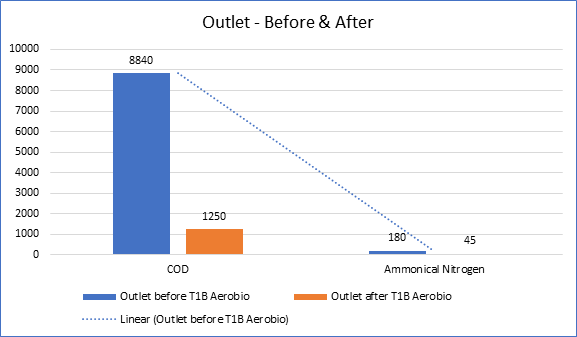API CASE STUDY – Wastewater Treatment in multinational API pharmaceutical company
Introduction:
API and bulk drug manufacturers generate a considerable amount of wastewater through their manufacturing, washing, and cleaning processes. One Indian multinational pharmaceutical company encountered significant challenges in managing the high organic load produced from their manufacturing processes, specifically at a factory located in Gujarat GIDC, where they manufacture multiple APIs.
Details provided for Effluent Treatment Plant (ETP):
- Primary, Biological and Tertiary systems, with RO & MEE.
- The activated sludge process (ASP) has one anoxic tank and 3 aeration tanks in series.
- Flow: Around 125 m3/day
- Inlet COD: 18,000 to 22,000 ppm
- COD outlet after biological treatment: 9000 to 17000 ppm
Findings and Challenges:
- Despite the high amount of MLSS & MLVSS in all aeration tanks, COD, BOD, and Ammoniacal Nitrogen levels consistently exceeded discharge limits.
- The EHS department of the industry faced pressure to maintain parameters according to PCB norms.
- The implementation of an MBR after the ASP process, as recommended by some consultants, failed to produce satisfactory results.
The Approach:
The solution offered by Team One Biotech is a comprehensive strategy for improving the biological treatment of wastewater generated by API and bulk drug manufacturers. This strategy includes the use of robust microbial consortia and the implementation of various processes and technologies to optimize the performance of the Effluent Treatment Plant (ETP). Some specific solutions offered by Team One Biotech include:
1. Introduction of T1B Aerobio: Team One Biotech devised a 60-day dosing schedule that incorporated T1B Aerobio strategically. This microbial product was used to raise the population of healthy microbes naturally and sustain a consistent population within the system.
2. Increase in Flow rate: Team One Biotech aimed to achieve a flow rate of 225 m3/day by the 60th day. They gradually increased the flow rate on a weekly basis, starting from an initial flow rate of 120 m3/day. This increase in flow rate was achieved without compromising on the outlet parameters.
3. Wastewater Microbiome Analysis (WMA): Team One Biotech conducted a WMA to understand the current biological health of the plant. This analysis helped identify deficiencies in the appropriate biomass in the biological units and provided insights for developing effective solutions.
4. Implementation of MangEfficient microbes: Team One Biotech incorporated their MangEfficient microbes into the strategy for the API bulk drug Pharma unit. These microbes were used to enhance the treatment process and improve wastewater quality.
5. Elimination of shock loads: Team One Biotech eliminated shock loads by transitioning to a continuous flow rate, avoiding any abrupt or sudden changes in the biological process. This helped maintain consistent performance of the ETP.
6. Reduction in COD, ammonical nitrogen, and electricity usage: The solution provided by Team One Biotech resulted in more than 80% reduction in COD values, more than 70% reduction in ammonical nitrogen, and savings in terms of electricity usage.
Results:
- We observed 85.8% reduction in COD and 75% reduction in TAN levels after 60 days and today the COD is in the range of 500 to 450 ppm in their biological outlet.
- MLSS lowered from earlier 18000 ppm to around 8000 to 10,000 ppm in all the 3 tanks.
- Use of MBR and the electricity to run the same, was eliminated.
- Improved the flow rate by 12% without compromising on the outlet parameters.
Six Months Progress:
- Eliminated shock loads by continuous feed
- Carries out WMA to understand their current biological health
- Introduced T1B Aerobic considering the plant conditions and their current process

After six months of monitoring, it’s evident that the outlet from the biological units consistently decreased despite fluctuating incoming loads. This consistent outcome suggests that our resilient microbial consortia effectively controlled all biological units.
Client Testimonial:
“When we partnered with this T1B team, we were not really sure about the output, though we were confident that they would make some positive impact, but we didn’t anticipate the extent of the success we would achieve. We were struggling with low ETP performance & high cost in terms of electricity and solid handling not realizing the full potential of our Effluent Treatment Plant. Their team came in with a clear, well-thought-out strategy covering all aspects of the ETP in terms of performance, process and savings.
The results speak for themselves — more than 80% reduction in COD values, more than 70% reduction in ammonical nitrogen and saving in terms of electricity & solid handling. I wholeheartedly recommend their services to any business looking to revamp their digital marketing strategy and see real, quantifiable results.”
Connect with our experts:
+91 8855050575/sales@teamonebiotech.com

